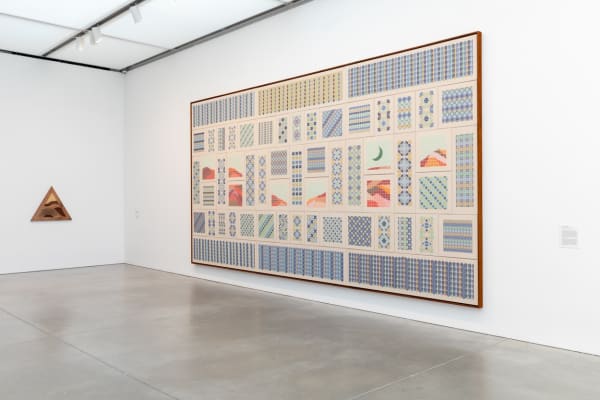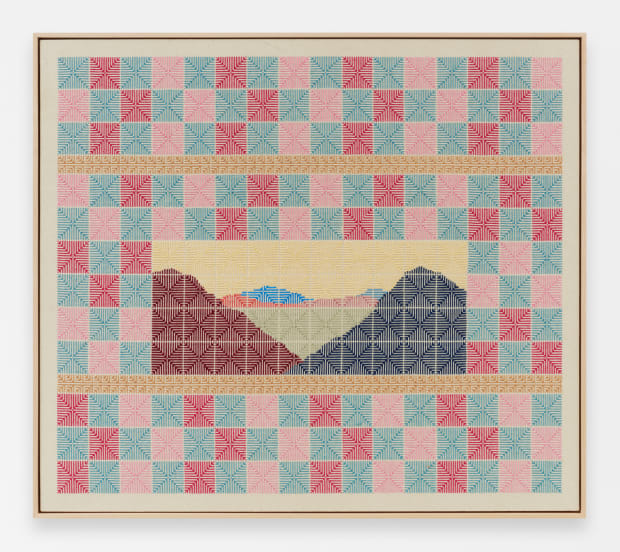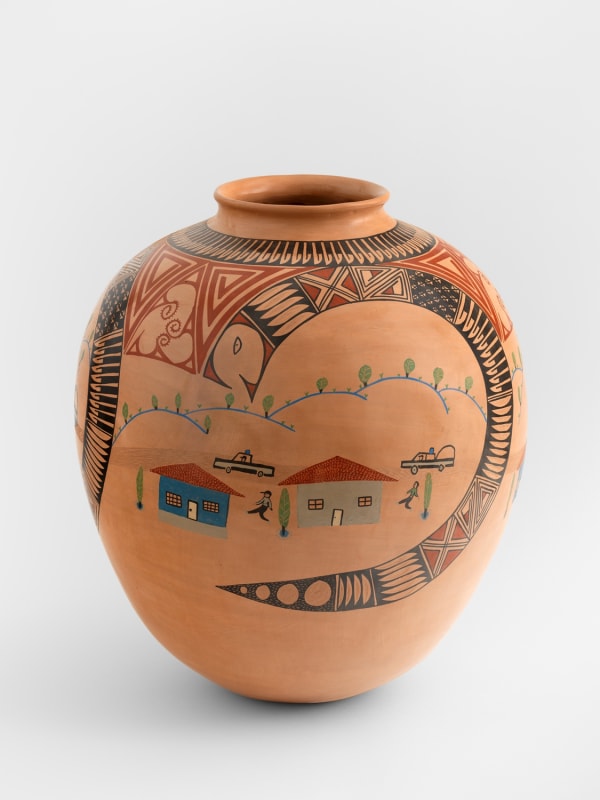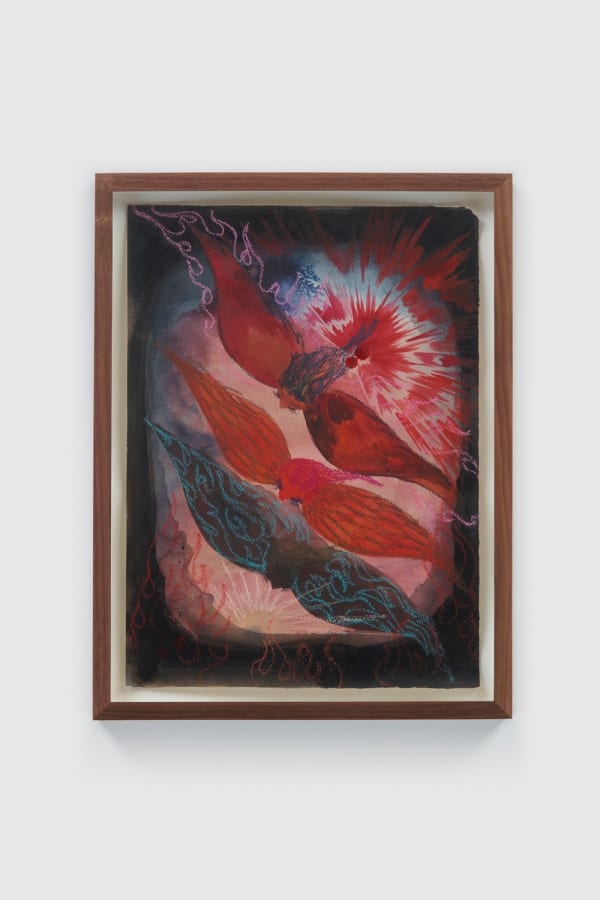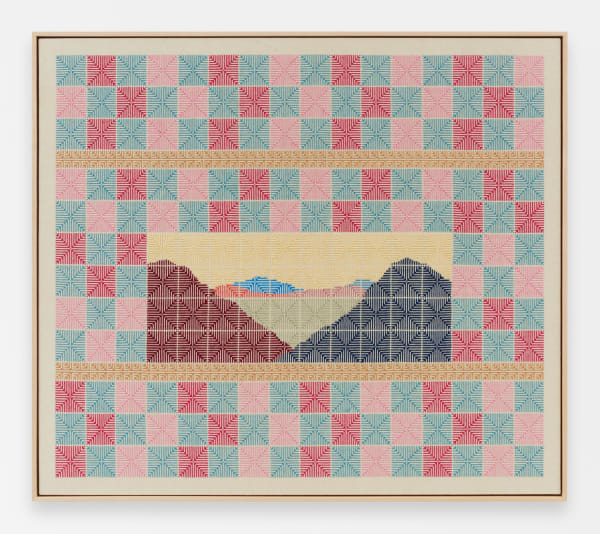-
For the 2023 edition of Frieze Los Angeles, James Cohan will present a selection of new and important work by Byron Kim, Mernet Larsen, Teresa Margolles, Jordan Nassar, Tuan Andrew Nguyen, Eamon Ore-Giron, Naudline Pierre, and Yinka Shonibare CBE. The fair is open to the public from February 18th through the 19th, with VIP Preview days on the 16th and 17th.
View a selection of works from our booth ahead of the fair below.
-
Jordan Nassar
-
Lament of the Field (2022), is one of two monumental embroideries, Jordan Nassar's largest to date, created on the occasion of his solo exhibition Fantasy and Truth, at the Institute of Contemporary Art/Boston which was on view from Aug 11, 2022 – Jan 29, 2023. Each contains fifty-seven individual panels. The title–Lament of the Field—is pulled from "A Tear and A Smile" (1914) by Lebanese-American writer Gibran Khalil Gibran (1883–1931).
Curator Anni Pullagura writes, “Gibran’s melancholic poetics address the ebb and flow of memory, time, and history; similarly, for Nassar, embroidery holds a tension between conflict and harmony in the relationship between stitch and thread, color and pattern. These painterly panoramas fuse complex patterning with close attention to form and color, and appear to exceed the boundaries of their frames to travel across the canvas and beyond it, suggestive of an expansive sky or a boundless horizon.”
Throughout Nassar’s work, viewers encounter fragments of landscapes (an experience not unlike memories that fade over time and our collective efforts to recall them). A red-hued valley dips downward in Lament of the Field (2022), illuminated by a green crescent moon. In these imagined geographies, we find relationships that once were and could, perhaps, be again. “I like to discuss these landscapes as versions of Palestine as they exist in the minds of the diaspora, who have never been there and can never go there,” says the artist. “They are the Palestine I heard stories about growing up, half made of imagination. They are dreamlands and utopias that are colorful and fantastical—beautiful and romantic, but bittersweet.”
-

-
TERESA MARGOLLES
-
In her ongoing investigation of the social and aesthetic dimensions of conflict, Teresa Margolles visualizes the enduring weight of violence. By infusing artwork with material traces of loss, she shares the stories of the disenfranchised in ways that are acutely visceral, confronting viewers physically and emotionally.
-
El poder, el mal y la muerte/Power, evil and death (2021) is a series of five painted ceramic vessels from Margolles's continued collaboration with artisans in the Northern Mexican state of Chihuahua, near the U.S./Mexico border. Located in the region near the prehistoric Paquime archaeological zone or Casas Grandes (the place of the big houses) the ceramicists have suffered greatly from the escalating violence in the area. This collaboration has resulted in a three-dimensional crónica (chronicle) that visually recounts events affecting the population. These vignettes depict contemporary cars and houses amid the geometric fretwork traditionally used in pre-Columbian Paquime pottery. Upon looking closely, the quotidian is violently disrupted by illustrations of car crashes, explosions, and machetes—brutal scenes from a persistent conflict. There is a gun depicted on almost every pot. Power, evil, and death are, according to the artist, the three elements that appear on pot 1, symbolized by the bull, the snake, and skull and crossbones.
-
Mernet Larsen
-
Combining reverse, isometric, and conventional perspectives, Mernet Larsen casts everyday scenarios into a vertigo-inducing version of reality akin to our own. Developed over the last 40 years, Larsen’s independent and meticulous approach to narrative painting “reaches toward, not from, life.”
-

-
Larsen’s paintings are simultaneously rooted in and distant from reality. Taking inspiration from the geometric abstractions of El Lissitzky and the narrative stylization of twelfth-century Japanese and early Renaissance paintings, Larsen’s vertiginous spaces often rendered in reverse perspective, and hard edged figures offer familiar versions of reality that are analogous and parallel to our own.
-
Naudline Pierre
-
Naudline Pierre’s paintings draw from fantasy and iconography to conjure alternate worlds. The artist's winged figures are enveloped in vast, horizonless landscapes, where they come together in acts of intimacy and salvation: they reach longingly outward toward each other, congregate, and embrace, emoting protection and care.
-

-

-
Tuan Andrew Nguyen
-
Across the sculptures that comprise this series, Tuan Andrew Nguyen subjects the 57mm brass artillery shells to varying degrees of physical transformation. They are shaped by Nguyen’s belief in the possibility of material reincarnation: of reconfiguring objects of war into spiritual objects capable of healing.
-

-
Byron Kim
-
Byron Kim’s latest series, “B.Q.O.,” is an acronym for Berton, Queequeg, and Odysseus, three important characters from famous oceanic tales: Stanisław Lem's Solaris, Herman Melville’s Moby Dick, and Homer’s The Odyssey.
Expanding on his ongoing practice of portraiture, this work is an oceanic portrait, based on photographs taken by the artist or drawn from personal memory. The work comprises three panels that represents a distinct visual zone: the bottom panel captures the view of the ocean from underwater, the middle panel the water’s surface and its reflection, and the upper panel the sky. For Kim, these segmented depictions of bodies of water find parallel with the human body, with the zones of sky, surface, and underwater relating to head and throat, chest and belly, and base, respectively.
-

-
Yinka Shonibare CBE
-
Playfully described by the artist as “Picasso in reverse”, Yinka Shonibare's African masks engage with the artist’s own identity as a ‘post-colonial hybrid’. This new body of work explores the relationship between African aesthetics and western modernist expression by recreating African masks from Picasso’s personal collection and adorning them with patterns that evoke Shonibare’s signature Dutch wax printed fabrics. Themselves appropriations of Indonesian batiks, which were remade by the Dutch and sold to the West African market, Dutch wax textiles exemplify the messiness of cultural origins that the artist seeks to highlight. As Shonibare explains, “Picasso was interested in appropriating from another culture, and I also appropriate from European ethnic art.” Challenging notions of cultural authenticity, Shonibare encourages a new conversation on diaspora within contemporary society.
-
Selected Works
-
 JORDAN NASSAR, Lament of the Field, 2022
JORDAN NASSAR, Lament of the Field, 2022 -
 JORDAN NASSAR, At Dawn and in the West, 2022
JORDAN NASSAR, At Dawn and in the West, 2022 -
 TERESA MARGOLLES, El poder, el mal y la muerte /Power, evil and death, 2021
TERESA MARGOLLES, El poder, el mal y la muerte /Power, evil and death, 2021 -
 MERNET LARSEN, The Blue Umbrella, 2022
MERNET LARSEN, The Blue Umbrella, 2022
-
Frieze Los Angeles
Past viewing_room

